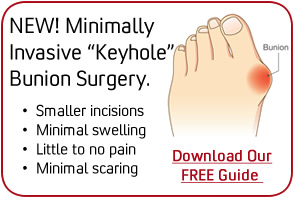|
Ankle Fractures
A fall, an accident, or a hard blow may cause one or more bones in the ankle to fracture or break. Depending on the type of injury, an ankle may fracture in several ways. Spiral fractures may result from twisting injuries. If bone pulls away from bone, the break is often straight. After a bad fall, or a heavy blow, bone may be crushed. Although ankle fractures tend to cause pain, you may be able to walk on the ankle. However, this is not a good idea. Your physician should check any injured ankle. Treatment Your treatment depends on where and how badly your ankle has been broken. Your physician will feel your ankle and foot for swelling and any displaced bones. He or she may also check to see if the ankle joint still moves. Depending on how the injury occurred, your physician may examine your leg from the knee down. X-rays will be taken to show the type of break, its exact location, and the extent of the damage. After a fracture, a cast may be used to hold the bone in its proper position for healing. Sometimes the sections of broken bone must first be realigned. This is called reduction. The type of reduction is based on how far the bone has moved from its normal position. Closed Reduction If you have a clean break with little soft tissue damage, closed reduction may be used. Before the procedure, you may be given a light anesthetic to relax your muscles. Then your doctor manually readjusts the position of the broken bone. Open Reduction If you have an open fracture (bone sticking out through the skin), badly misaligned sections of bone, or severe tissue injury, an open reduction will be used. A general anesthetic may be used during the procedure to let you sleep and relax your muscles. Your doctor then makes one or more incisions to realign the bone and repair soft tissues. Screws or plates may be used to hold the bone in place during healing. Casting a Fracture To make sure the bone is aligned properly, an x-ray is taken. The ankle is then put in a cast to hold the bone in place during healing. You will probably have to wear the cast for 4 to 8 weeks. For less severe fractures, a walking boot, brace, or splint may be all that is needed to hold the bone in place during healing. Once your fracture has been treated, your physician will tell you how to help it heal. You may be told to limit your use, take medications, and elevate the foot. If you have a cast, remember to keep it dry. To reduce swelling and control pain, elevate the ankle above the level of your heart. This simple action can help control symptoms throughout your recovery. Protect your ankle by giving it enough time to heal. When you do become active again, expect some swelling and stiffness. To build strength and help avoid re-injury, your physician may prescribe physical therapy or home exercise. Ankle support may also help. Exercise increases the flexibility of your ankle. If your physician agrees, try the following exercise. Use your foot to write out the alphabet in the air. Be sure to work from the ankle and foot, not from the knee. Article provided by PodiatryNetwork.com.
|










